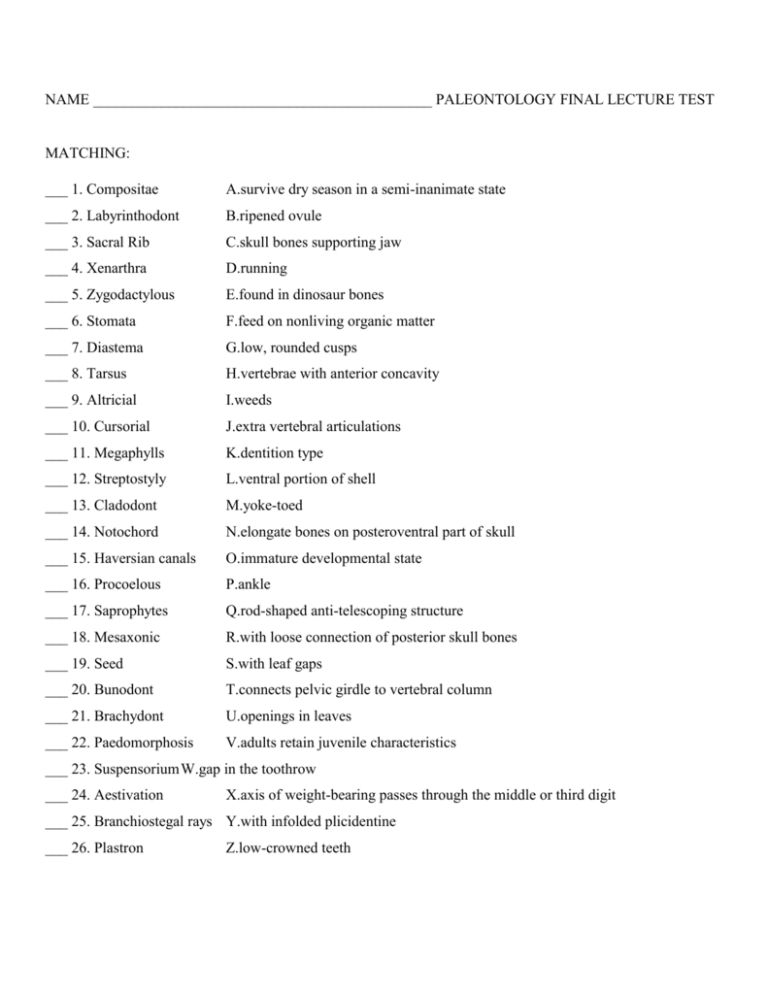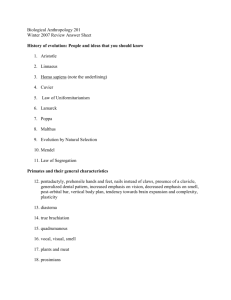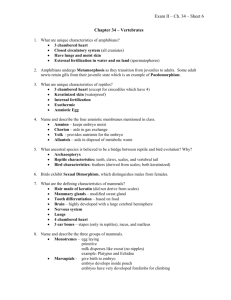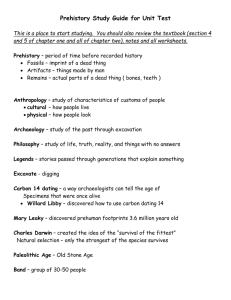Paleo Lecture 3
advertisement

NAME _____________________________________________ PALEONTOLOGY FINAL LECTURE TEST MATCHING: ___ 1. Compositae A.survive dry season in a semi-inanimate state ___ 2. Labyrinthodont B.ripened ovule ___ 3. Sacral Rib C.skull bones supporting jaw ___ 4. Xenarthra D.running ___ 5. Zygodactylous E.found in dinosaur bones ___ 6. Stomata F.feed on nonliving organic matter ___ 7. Diastema G.low, rounded cusps ___ 8. Tarsus H.vertebrae with anterior concavity ___ 9. Altricial I.weeds ___ 10. Cursorial J.extra vertebral articulations ___ 11. Megaphylls K.dentition type ___ 12. Streptostyly L.ventral portion of shell ___ 13. Cladodont M.yoke-toed ___ 14. Notochord N.elongate bones on posteroventral part of skull ___ 15. Haversian canals O.immature developmental state ___ 16. Procoelous P.ankle ___ 17. Saprophytes Q.rod-shaped anti-telescoping structure ___ 18. Mesaxonic R.with loose connection of posterior skull bones ___ 19. Seed S.with leaf gaps ___ 20. Bunodont T.connects pelvic girdle to vertebral column ___ 21. Brachydont U.openings in leaves ___ 22. Paedomorphosis V.adults retain juvenile characteristics ___ 23. Suspensorium W.gap in the toothrow ___ 24. Aestivation X.axis of weight-bearing passes through the middle or third digit ___ 25. Branchiostegal rays Y.with infolded plicidentine ___ 26. Plastron Z.low-crowned teeth MULTIPLE CHOICE: ___ 27. Hedgehogs, shrews and moles are A.chiropterans B.strepsirhines C.liptotyphlans D.lagomorphs E.creodonts ___ 28. Masseter attachment patterns and morphology of the lower jaw are important in classification of A.chiropterans B.lagomorphs C.rodents D.perissodactyls E.carnivores ___ 29. ? had an Australopithecus - like face and palate; brain size was approximately 750 milliliters. A.Homo rudolfensis B.Homo erectus C.Homo ergaster D.Australopithecus E.Paranthropus ___ 30. The gomphotheres and deinotheroids were A.elephants B.rhinos C.horses D.deer E.carnivores ___ 31. Entelodonts were pig-like A.artiodactyls B.perissodactyls C.litopterns D.notoungulates E.diprotodonts ___ 32. The ramamorphs, pongids and hylobatids are A.plesiadapiforms B.strepsirhines C.haplorhines D.hominoids E.platyrrhines ___ 33. The ? includes the sealions and fur seals. A.phocids B.ursids C.odobenids D.canids E.otariids ___ 34. The Edentata is A.monophyletic B.polyphyletic ___ 35. The baleen whales are A.mesonychids B.archeocetes C.sirenians D.mysticetes E.odontocetes ___ 36. The Mousterian Tradition is typically attributed to A.Homo rudolfensis B.Homo erectus C.Homo ergaster D.Homo neanderthalensis E.Homo sapiens ___ 37. “Punch-struck” blade industries are characteristic of the ? Paleolithic. A.Lower B.Middle C.Upper ___ 38. The ? were sharks that had wierd dorsal fins shaped like brushes; they are the best known Paleozoic sharks. A.iniopterygians B.eugeneodonts C.xenacanths D.hybodonts E.symmoriids ___ 39. Most primates ? a hypocone. A.have B.do not have ___ 40. The carnassials of ? usually involved M1+2/M2+3. A.chiropterans B.lagomorphs C.creodonts D.perissodactyls E.carnivores ___ 41. The litopterns and notoungulates were most common in A.North America B.South America C.Europe D.Asia E.Africa ___ 42. Moropus , a horse-sized clawed bipedal browser from the Miocene of North America, was a A.elephant B.diprotodont C.rhino D.brontothere E.chalicothere ___ 43. The ? were giant, armadillo-like mammals of the Tertiary and Quaternary. A.dasypodids B.glyptodonts C.pholidotans D.mylodontoids E.megalonychoids ___ 44. The largest known land carnivores (or scavengers) were A.cetaceans B.ursids C.canids D.felids E.mesonychids ___ 45. Giraffes have A.horns B.antlers C.ossicones ___ 46. The formation of the ectotympanic into a tube leading outward from the auditory bulla is important in classification of the A.Rodentia B.Primates C.Carnivora D.Perissodactyla E.Lagomorpha ___ 47. In the ?, the main branch of the internal carotid artery is reduced or lost and the external carotid has a countercurrent exchanger in the vicinity of the orbit for cooling blood entering the brain. A.primates B.arctoids C.rodents D.aeluroids E.lagomorphs ___ 48. The trimerorhacids, dissorophids and metoposaurs were A.ichthyostegids B.lissamphibians C.temnospondyls D.lepospondyls E.seymouriamorphs ___ 49. ? have a “single-pulleyed” astragalus. A.artiodactyls B.perissodactyls C.litopterns D.notoungulates E.diprotodonts ___ 50. Ursids have ? feet. A.plantigrade B.unguligrade C.digitigrade ___ 51. Many ? have a selenodont dentition. A.artiodactyls B.perissodactyls C.litopterns D.notoungulates E.diprotodonts ___ 52. The “parareptiles” were A.synapsids B.diapsids C.euryapsids D.anapsids ___ 53. The thylacine, or “pouched wolf” and the Tasmanian Devil are A.dasyurids B.peramelemorphs C.didelphimorphs D.sparassodonts E.diprotodonts ___ 54. The ? were aquatic reptiles that were utilized by Wegener as evidence of continental drift. A.Therapsids B.Mesosaurs C.Placodonts D.Pelycosaurs E.Mosasaurs ___ 55. The snake-like aistopods and the wierd boomerang-headed Diplocaulus were A.ichthyostegids B.lissamphibians C.temnospondyls D.lepospondyls E.seymouriamorphs ___ 56. All bipedal carnivorous dinosaurs are A.ornithopods B.pachycephalosaurs C.sauropodomorphs D.theropods E.ankylosaurs ___ 57. ? were pteraspidomorphs with narrow oral plates, upon which there were tiny backward-pointing denticles probably used in capturing prey. A.cyclostomes B.heterostracans C.osteostracans D.anaspids E.thelodonts ___ 58. The ? were aquatic reptiles with a hypocercal tail and greatly-enlarged eyes; they appear to have given birth to live young. A.Testudines B.Mesosauria C.Ichthyopterygia D.Lepidosauromorpha E.Archosauromorpha ___ 59. The most important group of land birds are the A.falconiformes B.ratites C.passeriformes D.strigiformes E.charadriiformes ___ 60. Some ? are syndactylous. A.marsupials B.placentals C.multituberculates D.tricondonts E.monotremes ___ 61. The ? include the “fruit bats” or “flying foxes”. A.plesiadapiforms B.strepsirhines C.haplorhines D.microchiropterans E.megachiropterans ___ 62. The “Crurotarsi” belonged to the A.Testudines B.Mesosauria C.Ichthyopterygia D.Lepidosauromorpha E.Archosauromorpha ___ 63. Cattle and deer have ?-chambered stomachs. A.one B.two C.three D.four E.five ___ 64. Rhamphorhynchoids were types of A.bats B.birds C.pterosaurs D.saurischians E.ornithischians ___ 65. The last dinosaurs became extinct during the A.Pennsylvanian B.Permian C.Triassic D.Jurassic E.Cretaceous ___ 66. The hypocondulid and entoconid are twinned and is separated from the hypoconid in the A.marsupials B.placentals C.multituberculates D.tricondonts E.monotremes ___ 67. ? are heterotrophs that secrete enzymes which are able to break down external food sources into molecules small enough to be absorbed by the cells. A.rhyniopsids B.lycopsids C.sphenopsids D.filicopsids E.fungi ___ 68. In ?, there are pedicillate teeth and there is a muscular connection between the ear and the shoulder girdle. A.ichthyostegids B.lissamphibians C.temnospondyls D.lepospondyls E.seymouriamorphs ___ 69. The ? were the largest land animals of all time. A.diplodocids B.cetiosaurids C.prosauropods D.brachiosaurids E.camarasaurids ___ 70. The ? have “double fertilization”. A.Anthophyta B.Coniferales C.Ginkgoales D.Pteridospermophyta E.Cycadophya ___ 71. The ? were microphylls in which bolsters were present on the trunks; they include the genera Lepidodendron, Lepidophloios, Sigillaria and Stigmaria. A.Rhyniophyta B.Sphenopsida C.Zosterophyllopsida D.Psilopsida E.Lycophyta ___ 72. Loss of the intertemporal bone, palatal “fangs”, and labyrinthine infolding of the teeth, coupled with the development of the atlas and axis complex and astragalus and calcaneum is characteristic of A.osteolepiforms B.amphibians C.reptiles D.birds E.mammals ___ 73. The ? were rodent-like Mesozoic mammals; they were the most diverse and numerous mammals of the Mesozoic. A.symmetrodonts B.docodonts C.multituberculates D.tricondonts E.monotremes ___ 74. ? were robust australopithecines. A.Homo rudolfensis B.Homo erectus C.Homo ergaster D.Australopithecus E.Paranthropus ___ 75. Brontotheres and chalicotheres were A.artiodactyls B.perissodactyls C.litopterns D.notoungulates E.diprotodonts ___ 76. Parenchyma tissues, alternation of generations, and the presence of sporopollenin is characteristics of the A.Chrysophyta B.Rhodophyta C.Phaeophyta D.Chlorophyta E.Plantae ___ 77. The “Great Faunal Interchange” was between A.Africa and Asia B.Africa and Europe C.Europe and Asia D.Asia and North America E.North America and South America ___ 78. ? were pony-sized aquatic animals with short, stout limbs and short shovel-like tusked mouth; each cheek tooth was made of a cluster of stout dentine tubules. A.desmostylians B.sirenians C.odobenids D.cetaceans E.otariids ___ 79. The “fin-backed” reptiles, such as Dimetrodon, were A.Therapsids B.Mesosaurs C.Placodonts D.Pelycosaurs E.Mosasaurs ___ 80. The “Turkana Boy” is often classified as A.Homo rudolfensis B.Homo habilis C.Homo ergaster D.Australopithecus E.Paranthropus ___ 81. ? were ancestral to the microphyllous plants; the sporangia were kidney-shaped and they were “Hbranched”. A.Rhyniophyta B.Sphenopsida C.Zosterophyllopsida D.Psilopsida E.Lycophyta ___ 82. In the ?, the vertebrae and ribs are fused to the shell and the limbs and limb girdles are modified for a sprawling posture. A.Testudines B.Mesosauria C.Ichthyopterygia D.Lepidosauromorpha E.Archosauromorpha ___ 83. Arborescent lycopods, sphenopsids and most tree ferns became extinct during the A.Mississippian B.Pennsylvanian C.Permian D.Cretaceous E.Pleistocene ___ 84. ? is capable of “expansional growth”. A.cartilage B.bone C.both bone and cartilage are capable of “expansional growth” ___ 85. Most ? are evergreens; they include the pines, spruces and firs. A.Cordaitales B.Coniferales C.Ginkgoales D.Pteridospermophyta E.Cycadophya ___ 86. During the Miocene, climate became ? in North America. A.wetter B.drier ___ 87. The “uintatheres” were A.taeniodonts B.dinoceratans C.embrithopods D.tillodonts E.condylarths ___ 88. The oldest amphibians were of ? age. A.Silurian B.Devonian C.Mississippian D.Pennsylvanian E.Permian ___ 89. The duckbill platypus and echidna are A.symmetrodonts B.docodonts C.multituberculates D.tricondonts E.monotremes ___ 90. The ? include the Tertiary-age “bear dogs”. A.mustelids B.ursids C.procyonids D.canids E.amphicyonids ___ 91. In ?, there is an evolutionary trend in the posterior extension of the palatal bones. A.crocodiles B.aetosaurs C.rauisuchians D.phytosaurs E.dinosaurs ___ 92. The ? was a “pebble tool” culture. A.Acheulian B.Mousterian C.Aurignacian D.Perigordian E.Oldowan ___ 93. The ? have small leaves arranged in whorls around a photosynthetic stem; they include the ancient genera Calamites and Annularia. A.Rhyniophyta B.Sphenopsida C.Zosterophyllopsida D.Psilopsida E.Lycophyta ___ 94. ? have a double occipital condyle, a specialized axis-atlas complex, and the long bones have epiphyses. A.placoderms B.amphibians C.reptiles D.birds E.mammals ___ 95. The borhyaenids and thylacosmilids were A.dasyurids B.peramelemorphs C.didelphimorphs D.sparassodonts E.diprotodonts ___ 96. The typotheres, toxodonts and astrapotheres were A.notoungulates B.dinoceratans C.taeniodonts D.litopterns E.tillodonts ___ 97. The Anura, Urodela and Apoda are types of A.ichthyostegids B.lissamphibians C.temnospondyls D.lepospondyls E.seymouriamorphs ___ 98. The oldest undisputed eutherian is from the ? of Mongolia. A.Pennsylvanian B.Permian C.Triassic D.Jurassic E.Cretaceous ___ 99. The adapids, lemurs and lorises are A.plesiadapiforms B.strepsirhines C.haplorhines D.microchiropterans E.megachiropterans ___ 100. Which of the following is a pecoran? A.cattle B.deer C.giraffe D.antelope E.all of the above are pecorans ___ 101. The kangaroos are A.thylacoleonids B.phascolarctoids C.macropodids D.didelphimorphs E.sparassodonts ___ 102. The ? include the tree sloths, anteaters and armadillos, and the extinct glyptodonts and ground sloths. A.Proboscidea B.Hyracoidea C.Sirenia D.Xenarthra E.Desmostylia ___ 103. The “Eve Hypothesis” concerns the origin of A.Homo rudolfensis B.Homo sapiens C.Homo ergaster D.Australopithecus E.Paranthropus ___ 104. The ? have a “telescoped” skull; the maxillae may touch the bones at the back of the braincase. A.cetaceans B.ursids C.canids D.felids E.sirenians ___ 105. Which of the following is not part of the pelvis? A.scapula B.ischium C.pubis D.ilium ___ 106. In ?, the fourth finger supports the wing membrane. A.birds B.pterosaurs C.bats ___ 107. Which of the following is an “afrothere”? A.tenrec B.aardvark C.elephant shrew D.elephant E.all of the above are “afrotheres” ___ 108. The hyomandibular formed the A.stapes B.malleus C.incus D.the hyomandibular formed all of the above ___ 109. The most common cephalaspidomorphs were the ?; these fish had dorsal eyes and dorsal and lateral fields that probably functioned as sensory organs. A.cyclostomes B.heterostracans C.osteostracans D.anaspids E.thelodonts ___ 110. Turtles are A.synapsids B.diapsids C.euryapsids D.anapsids ___ 111. ? are the oldest undisputed birds. A.archaeopterygids B.charadriiformes C.ichthyornithiformes D.anseriformes E.hesperonithiformes ___ 112. The “Cetartiodactyla” includes A.whales B.mesonychids C.horses D.cattle E.all of the above are “cetartiodactyls” ___ 113. Approximately 40% of all known modern mammalian species are A.chiropterans B.lagomorphs C.rodents D.perissodactyls E.carnivores ___ 114. Ratites have a ? palate. A.palaeognathous B.neognathous C.it depends upon the type of ratite ___ 115. The “seed ferns” belonged to the A.Cordaitales B.Coniferales C.Ginkgoales D.Pteridospermophyta E.Cycadophya ___ 116. The marsupials are sometimes classified as the A.Metatheria B.Tethytheria C.Prototheria D.Eutheria E.Proboscidea ___ 117. The tetanurans, which have maxillary fenestra and pleurocoelous vertebrae, are A.ornithopods B.pachycephalosaurs C.sauropodomorphs D.theropods E.ankylosaurs ___ 118. The xylem and phloem are characteristic of A.chrysophytes B.rhodophytes C.phaeophytes D.chlorophytes E.tracheophytes ___ 119. ? are lobe-finned fish in which the braincase has an intracranial joint; they were believed to have become extinct during the Cretaceous but a surviving genus was discovered during the 20th century. A.acanthodians B.coelacanths C.placoderms D.actinopterygians E.osteolepiforms ___ 120. The cercopithecid, or “old world monkeys”, are A.creodonts B.platyrrhines C.catarrhines D.pantodonts E.dinoceratans ___ 121. The oldest dinosaurs are of ? age. A.Pennsylvanian B.Permian C.Triassic D.Jurassic E.Cretaceous ___ 122. A ? is a symmetrical fish tail in which the vertebrae extend outward to the tip. A.heterocercal B.hypocercal C.homocercal D.diphycercal ___ 123. ? have a diphyodont dentition. A.osteichthyes B.amphibians C.reptiles D.birds E.mammals ___ 124. Elephant tusks are A.canines B.incisors C.it depends upon the type of elephant ___ 125. The oldest fishes are of ? age. A.Proterozoic B.Cambrian C.Ordovician D.Silurian E.Devonian ___ 126. Which of the following have a “crocodile-normal” ankle joint? A.crocodiles B.aetosaurs C.rauisuchians D.phytosaurs E.all of the above have a “crocodile-normal” ankle joint ___ 127. The ? were Jurassic-age, mouse-sized mammals that had an articular-quadrate and dentary-squamosal articulation. A.symmetrodonts B.docodonts C.multituberculates D.tricondonts E.monotremes ___ 128. The earliest reptiles were probably ? in habits. A.amphibious B.terrestrial ___ 129. In the ? the pubis pointed backward and there was a predentary. A.saurischians B.ornithischians ___ 130. The angle of the jaw is usually inflected medially and there is a stylar shelf on the upper molars in A.marsupials B.placentals C.multituberculates D.tricondonts E.monotremes ___ 131. The ichthyostegids ? ancestral to other tetrapod groups. A.were B.were not ___ 132. ? were typically dorsoventrally compressed fishes with head and trunk shields; in advanced types the shields were connected by a ball-and-socket articulation. A.acanthodians B.chondrichthyans C.placoderms D.actinopterygians E.sarcopterygians ___ 133. In teleosts, the ? becomes the primary tooth-bearing element in the upper jaw. A.maxilla B.squamosal C.dentary D.articular E.premaxilla ___ 134. Which of the following is a “tethythere”? A.hyrax B.dugong C.manatee D.elephant E.all of these are “tethytheres” ___ 135. The ? were aquatic reptiles of Jurassic and Cretaceous age; they had paddle-like appendages and their ventral ribs formed a basket-like structure. A.mesosaurs B.mosasaurs C.nothosaurs D.placodonts E.plesiosaurs ___ 136. ? had no leaves or roots, the stems were capped by sporangia, and they were homosporous. A.Rhyniophyta B.Sphenopsida C.Zosterophyllopsida D.Psilopsida E.Lycophyta ___ 137. The oldest ceratopsians were ? age. A.Pennsylvanian B.Permian C.Triassic D.Jurassic E.Cretaceous ___ 138. ? have a notochord, dorsal hollow nerve cord, and an endostyle organ. A.echinoderms B.hemichordates C.calcichordates D.chordates E.all of the above have a notochord, dorsal hollow nerve cord, and an endostyle organ ___ 139. Most modern plants belong to the A.Anthophyta B.Coniferales C.Ginkgoales D.Pteridospermophyta E.Cycadophya ___ 140. The bolosaurids, procolophonoids and pareisaurs were A.carnivores B.herbivores ___ 141. The primitive ray-finned fish tail was A.hypocercal B.diphycercal C.homocercal D.heterocercal ___ 142. Some ? are diprotodont. A.marsupials B.placentals C.multituberculates D.tricondonts E.monotremes ___ 143. Pleurodonty is characteristic of many A.crocodilians B.dinosaurs C.phytosaurs D.lizards E.rhynchosaurs ___ 144. In the ?, the wings are supported by four fingers. A.pterosaurs B.birds C.bats D.in all of the above, the wings are supported by four fingers ___ 145. The ? were shrub- or tree-like plants with pinnately-compound, strap-like leaves; the male and female cones were very similar. A.Cycadeoidophyta B.Coniferales C.Ginkgoales D.Pteridospermophyta E.Cycadophya ___ 146. The ? were primarily freshwater sharks that had a diphycercal caudal fin; the teeth had two or three pointed cusps and there were two anal fins. A.iniopterygians B.eugeneodonts C.xenacanths D.hybodonts E.symmoriids ___ 147. ? have a urostyle and a rod-shaped ilium; the skull forms an “open” structure and there are only 5 to 9 ribless vertebrae. A.Urodela B.Seymouriamorpha C.Anura D.Apoda E.Aistopoda ___ 148. The Cerapoda and Thyreophora were types of A.aetosaurs B.crocodilians C.ornithischians D.saurischians E.phytosaurs ___ 149. The ? gave rise to tetrapods. A.acanthodians B.coelacanths C.placoderms D.actinopterygians E.osteolepiforms ___ 150. A synsacrum, pygostyle and furcula are characteristic of A.bats B.birds C.pterosaurs D.saurischians E.ornithischians ___ 151. ? have a stapes, malleus and incus. A.osteichthyes B.amphibians C.reptiles D.birds E.mammals ___ 152. Dinocephalians and anomodonts were A.Therapsids B.Mesosaurs C.Placodonts D.Pelycosaurs E.Mosasaurs ___ 153. Prismatic cartilage is characteristic of the ?; they also typically have placoid scales, claspers and fin spines. A.acanthodians B.chondrichthyans C.placoderms D.actinopterygians E.sarcopterygians ___ 154. The ? were the giant Early Tertiary carnivorous “terror birds”. A.gruiformes B.diatrymiformes C.ratites D.phorusrhacids E.moas ___ 155. Dinosaurs ? determinant growth. A.had B.did not have ___ 156. The antiarchs were mud-grubbing ? with “arthropod-like” appendages. A.acanthodians B.chondrichthyans C.placoderms D.actinopterygians E.sarcopterygians ___ 157. The ? were heavily-built Triassic herbivorous lepidosaurians; advanced types had broad crushing toothplates and a parrot-like edentulous beak. A.trilophosaurs B.rhynchosaurs C.phytosaurs D.rauisuchians E.aetosaurs ___ 158. The “titanotheres” were A.elephants B.diprotodonts C.rhinos D.brontotheres E.chalicotheres ___ 159. The modern sharks, skates and rays are A.neoselachians B.eugeneodonts C.xenacanths D.hybodonts E.symmoriids ___ 160. The phytosaurs, aetosaurs and rauisuchians were of ? age. A.Pennsylvanian B.Permian C.Triassic D.Jurassic E.Cretaceous ___ 161. The Plantae evolved from A.chrysophytes B.rhodophytes C.phaeophytes D.chlorophytes E.monerans ___ 162. ? have fused trunk vertebrae, termed the notarium, and a splint-like pteroid on the wrist. A.bats B.birds C.pterosaurs D.saurischians E.ornithischians ___ 163. Modern sharks and ray-finned fish have ? jaws. A.hyostylic B.holostylic C.autostylic D.amphistylic ___ 164. Which of the following is not an aeluroid? A.hyaenid B.felid C.mustelid D.viverroid ___ 165. ? vertebrae have a wedge-shaped intercentrum and small paired pleurocentra. A.rhachitomous B.lepospondylous C.anthracosaurian D.stereospondylous E.embolomerous ___ 166. In the ?, the floral parts occur in groups of four or five; the leaves are usually “net veined” and they have two “seed leaves”. A.Monocotyledenoae B.Coniferales C.Ginkgoales D.Dicotyledonae E.Cycadophya ___ 167. Theropods were ? dinosaurs. A.saurischian B.ornithischian ___ 168. In ? jaw articulation in fishes, the upper jaws are fused to the braincase. A.hyostylic B.holostylic C.autostylic D.amphistylic ___ 169. ? had extensive development of a bony, armored carapace; they often had a tail club. A.ornithopods B.pachycephalosaurs C.sauropodomorphs D.stegosaurs E.ankylosaurs ___ 170. The ? are aquatic mammals whose blunt mouths have thick overhanging lips, and the ribs are thick and dense. A.desmostylians B.sirenians C.odobenids D.cetaceans E.otariids ___ 171. The most numerous Permian reptiles were A.synapsids B.diapsids C.euryapsids D.anapsids ___ 172. The formation of a trigon, trigonid and talonid are characteristic of A.osteichthyes B.amphibians C.reptiles D.birds E.mammals ___ 173. Lungfish have a ? jaw articulation. A.hyostylic B.holostylic C.amphistylic D.autostylic ___ 174. ? have no keeled sternum; the scapulo-coracoid forms and obtuse angle and there is an ilioischiatic fenestrum. A.falconiformes B.ratites C.passeriformes D.strigiformes E.charadriiformes ___ 175. Coelophysoids, ceratosaurs and ornithomimids were A.ornithopods B.pachycephalosaurs C.sauropodomorphs D.theropods E.ankylosaurs ___ 176. The predator/prey ratios of carnivorous dinosaurs to their prey is most similar to A.reptiles B.mammals ___ 177. The Sauropterygians belonged to the A.Testudines B.Mesosauria C.Ichthyopterygia D.Lepidosauromorpha E.Archosauromorpha ___ 178. ? have an upper temporal opening with the postorbital and squamosal meeting below. A.synapsids B.diapsids C.euryapsids D.anapsids ___ 179. The Gymnomycota, Mastigomycota and Amastigomycota are types of A.rhyniopsids B.lycopsids C.sphenopsids D.filicopsids E.fungi ___ 180. The largest land mammals were A.elephants B.diprotodonts C.rhinos D.brontotheres E.acreodi ___ 181. ? scales lost the ganoin and cosmine layers; they are thin circular scales with growth rings. A.cosmoid B.cycloid C.ganoid D.ctenoid ___ 182. The ? are paraxonic. A.artiodactyls B.perissodactyls C.litopterns D.notoungulates E.diprotodonts ___ 183. In ? vertebrae the pleurocentra were reduced or absent; these were found in many Late Permian and Triassic amphibians. A.rhachitomous B.anthracosaurian C.embolomerous D.lepospondylous E.stereospondylous ___ 184. The ? are megaphylls; the fronds are often pinnately compound and are circinate. A.Rhyniophyta B.Sphenopsida C.Filicinophyta D.Psilopsida E.Lycophyta ___ 185. The ? were the “bone-headed” dinosaurs. A.ornithopods B.pachycephalosaurs C.sauropodomorphs D.theropods E.ankylosaurs ___ 186. ? have a dentary condyle on the jaw articulating with a glenoid in the squamosal. A.osteichthyes B.amphibians C.reptiles D.birds E.mammals







